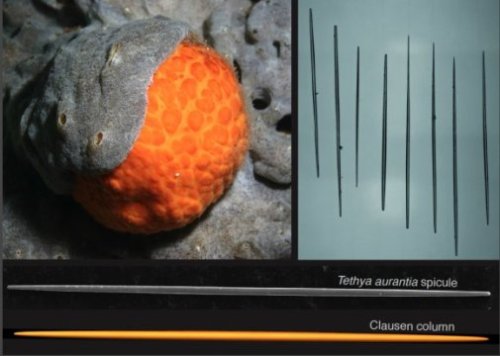#stiffness
Sea sponges offer clues to how human-made structures can resist buckling
Judging by their name alone, orange puffball sea sponges might seem unlikely paragons of structural strength. But maintaining their shape at the bottom of the churning ocean is critical to the creatures’ survival, and new research shows that tiny structural rods in their bodies have evolved the optimal shape to avoid buckling under pressure.
The rods, called strongyloxea spicules, measure about 2 millimeters long and are thinner than a human hair. Hundreds of them are bundled together, forming stiff rib-like structures inside the orange puffball’s spongy body. It was the odd and remarkably consistent shape of each spicule that caught the eye of Brown University engineers Haneesh Kesari and Michael Monn. Each one is symmetrically tapered along its length – going gradually from fatter in the middle to thinner at the ends.
Using structural mechanics models and a bit of digging in obscure mathematics journals, Monn and Kesari showed the peculiar shape of the spicules to be optimal for resistance to buckling, the primary mode of failure for slender structures. This natural shape could provide a blueprint for increasing the buckling resistance in all kinds of slender human-made structures, from building columns to bicycle spokes to arterial stents, the researchers say.
Post link
Scientists successfully test new, safer titanium plate for bone tissue repair
For the first time, patented titanium fiber plates developed by Japanese engineers for medical use have been tested in an animal model. Researchers from Shinshu University found that, unlike conventional plates, titanium fiber plates do not cause bone embrittlement after close contact with the bone for prolonged periods. This could eliminate the need for plate extraction and the associated surgical risks.
“Ourtitanium fiber plates, unlike conventional titanium plates, are prepared by compressing titanium fibers at normal room temperature into plates without changing the fiber shape,” said Takashi Takizawa, M.D., the paper’s first author from the department of orthopaedic surgery at the Shinshu University School of Medicine. “They can compensate for the major drawback of conventional titanium plates, and find application in a range of fixation and bone tissue repair uses at various sites of the body.”
Their results were published in the January 25th online issue of the journal Advanced Materials.
Most commonly used to hold bones in place while they heal, titanium plates are erosion resistant and strong enough to hold the mending bones in place. Doctors may elect to implant a titanium plate in a patient with a bad fracture, a severe skull injury, or a degenerative bone disease.
Post link


